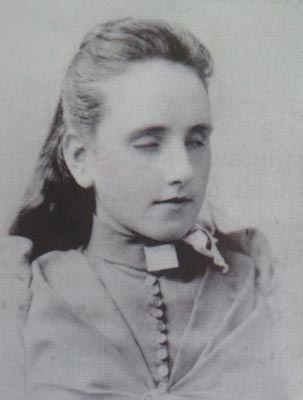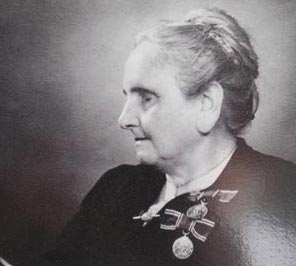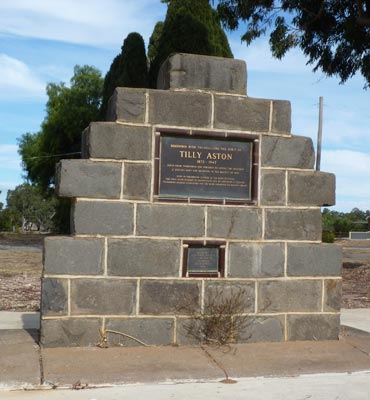I first came across the name Tilly Aston in an exhibition on Vision Impairment at the Victorian Museum in 2012. I later learnt more about this remarkable and inspiring woman by reading her Memoirs, as well as some of her poetry from her published collections.
Tilly Aston was born Matilda Ann Aston in Carisbrook on 11 December 1873 to a country boot maker and his wife. The township of Carisbrook, which Tilly described as ‘a sleepy little village’, is in central Victoria. In later life she was to claim that Carisbrook was the place ‘where so many good things could enter (her) soul’.
Tilly was the youngest of eight children. Unfortunately it was discovered that she was born with impaired eyesight. This eventually resulted in total loss of sight by her seventh year.
While she had some vision her parents encouraged her to experience as much of her childhood surroundings as possible. She was given the freedom to explore her world with all her senses. Reflecting on her childhood days, she wrote the following in her Memoirs.
‘I was taught to take notice of the things about me, natural objects, astral phenomena, the calls of birds and the like; also I was encouraged to make simple playthings for myself, to run wild in the bush with the other children, to climb trees, to prowl and investigate the surroundings of the old mines around the town. The independence thus acquired has been one of my chief assets.’
These early childhood experiences unconsciously created for her a rich repository of memories from which she could dip into throughout her life.
Tilly always believed in the importance of education. She passionately persued what she called ‘the great adventure of a serious search for knowledge’. She learnt to read Braille at an early age and her studies eventually took her to university. Bitterly disappointed, she was unable to complete her course. This was due to the lack of Braille resources for the vision impaired, despite her attempts to translate some of her text books.
Her lifelong love of music began with her family’s singing around their harmonium. She reckoned that she knew how to sing before she could talk, as both of her parents constantly sang to her. She took piano, violin and singing lessons. As an adult she taught music and gave singing recitals.
Inspired in her own reading by the lives of others without sight, she started a Braille library. She championed the importance of Braille and worked to have the heavy Braille books freely sent in the mail. Despite some bureaucratic resistance, she became the first blind teacher of the blind, teaching for nearly twelve years. She worked for the right of the blind to vote, to receive a pension and to travel interstate without economic hardship. Perhaps her most enduring legacy was the creation of the Association for the Advancement of the Blind, which was to evolve into what we now know as Vision Australia.
Although never marrying, many vision impaired people saw this as a positive. They unashamedly claimed her as their own, believing that she could not be shared with a family and all the responsibilities that would have entailed.A published author, of which she was always proud, she wrote three volumes of poetry, a memoir and many short stories for children. Many of the latter had a religious theme, as she practised her Christian beliefs throughout her life. On 1 November 1947 she died of cancer and was buried in St Kilda Cemetery, Melbourne.
I went to Carisbrook in April this year. It is still ‘a sleepy little village’. I visited the Tilly Aston Memorial Centre which was opened on 25 October 2014. The Centre comprises a large pergola structure which houses information and pictures documenting Tilly Aston’s life and achievements. It is appropriately positioned opposite the site of her former home and her father’s shop. Behind the Centre is the Wesleyan Church on the site of an earlier church that Tilly attended as a child.
Near to the Centre is a stone memorial that asks us to ‘remember with thanksgiving the spirit of Tilly Aston’. It was erected in 1970.
Carisbrook also remembers her through the Tilly Aston Achievement Awards that are presented every Australia Day.
Another memorial to Tilly Aston is a uniquely sculptured, bronze bell which stands on a pathway in the Melbourne Botanical Gardens in King’s Domain. Sculptured by Anton Hasell and positioned there in 1999, it commemorates the centenary of Vision Australia by acknowledging its founder.
Often the best people, who are able to understand and inspire those with a disability, are people who also have a similar disability. In my opinion, Tilly Aston’s life is confirmation of this. My life has been enriched by learning about her life, her positivity and her many achievements.
'Tis surely folly to assume that God Has placed the only medium in the eye Whereby our inner selves receive the good Found in the glories of the earth and sky.' (from Tilly Aston's poem The Power of Beauty)
© Jim Low June 2015
MORE:
- Listen to the song, Tilly Aston Knew, and read the lyrics
- Read Memoirs of Tilly Aston online (1946 Hawthorn Press)




